18 Facts to Know Before Going to the Valley of the Kings in Egypt
If you’re starting to plan your trip to Egypt (or just love Ancient Egyptian history), you’ve likely heard about the Valley of the Kings. In this article, I’ll share 18 facts about Valley of the Kings that you should know about before heading there to make the most of your visit.

The Valley of the Kings is where for nearly 500 years (from the 16th to 11th century BC), the tombs for the pharaohs and nobles were made. They are all located underground in this valley, so they would be hidden from looters. (A pyramid is a pretty big target for grave robbers, and they knew that by this period.)
And now, you can tour them! I know I know, touring tombs sounds kind of icky, but I swear – it’s an incredible place to visit! Some of the hieroglyphics and colors are so well-preserved it’s mind-boggling.
18 Facts to Know Before Going to the Valley of the Kings in Egypt
1. The Valley of the Kings is Located on the West Bank of the Nile River
The Valley of the Kings is nestled on the west bank of the Nile River. The city of Luxor is just a stone’s throw away.
This location was not a random choice. The ancient Egyptians believed that the journey to the afterlife began in the west, where the sun sets. Thus, the west bank of the Nile became a sacred burial ground for pharaohs and nobles.

2. The Valley is Renowned for Its Royal Tombs, Which Were Carved Into the Rock of the Surrounding Hills
The Valley of the Kings, as its name suggests, is famous for its royal tombs. These are not just any tombs, but ones that were meticulously carved into the rocks of the surrounding hills.
The tombs were constructed for the pharaohs and powerful nobles of the New Kingdom of Egypt. They are an architectural marvel, showcasing the artistic prowess and advanced engineering skills of the ancient Egyptians.
Each tomb is a labyrinth of chambers and corridors and is filled with intricate hieroglyphics that narrate the life and achievements of the tomb’s occupant.

3. The Valley Contains a Total of 63 Known Tombs, Although Not All of Them Belonged to Pharaohs
The Valley of the Kings contains a staggering total of 63 known tombs. But here’s a fascinating fact: not all of these tombs belonged to pharaohs!
While it’s true that many of the tombs were indeed resting places for Egypt’s ancient kings, others were built for beloved queens and even high-ranking officials, high priests, and other elites.
This diversity in the tomb occupants gives us a unique glimpse into the social hierarchy of ancient Egypt. It tells us that not just pharaohs but other important figures in society were given the honor of being buried in this sacred valley.
However, only a handful of them are open to the public (and they rotate which are open). This is due to renovations happening to certain tombs, and also to prevent damage to the tombs.
The tombs have been severely damaged by treasure hunters, floods, and, more recently, mass tourism: the carbon dioxide, friction, and humidity caused by the average 2.8g of sweat left by each visitor have damaged the reliefs and pigments of the wall paintings.
Since then, the Department of Antiquities has put dehumidifiers and glass screens in the most severely damaged tombs, as well as a rotation system for opening some tombs to the public while rehabilitating others.

4. You Don’t Simply “Pay an Entrance Fee” and Then Get to Wander
There are different fees for everything. Some tombs are included in a flat rate fee (however, once you pay the flat rate fee, you get to choose 3 tombs to visit).
Some tombs cost extra (such as King Tut and Seti I.) There’s also an extra fee if you want to take the little train up to the entrance (which I totally recommend doing – it’s a long walk and it’s super hot).

5. You Have to Pay Extra for Photography as Well
If you don’t, be sure to leave your camera in your bag, or they’ll ask you to leave your camera at the entrance (which seems sketchy to me). So, either don’t bring your camera or pay the fee. It was 300 LE to photograph 3 tombs when we visited in May 2019. That said, these rules are constantly changing, be sure to check with your guide before bringing your DSLR camera.
Also, you only get to photograph 3 tombs, and this needs to be purchased ahead of time at the visitors’ ticket kiosk. You also have to pay the fee if you want to photograph using your phone. (And if not, be sure to leave your phone in your bag or pocket!)
NOTE – You can’t take photos inside Seti I or King Tut’s tomb even if you pay the fee, though. (And please don’t be THAT person who just wants to sneak a pic. I saw this happening in King Tut’s tomb, and the guards were then bribed. Don’t be that person! Don’t encourage people to break these rules, pretty please. Let’s all be good tourists. )

6. It’s Going to be HOT
Did I mention Luxor is hotter than hell? Yeah, it’s terrible.
During the summer months, temperatures can rise up to a scorching 40 degrees Celsius (104 degrees Fahrenheit). Even in the cooler months, the sun can be quite intense. So, it’s always a good idea to come prepared.
Be sure to dress appropriately (I have a whole post filled with tips for how to dress for the heat in Luxor), bring a couple bottles of water, and LOTS of sunscreen.

7. Among the Most Famous Tombs in the Valley of the Kings is the Tomb of Tutankhamun
King Tutankhamun, often simply called King Tut, is one of the most famous Pharaohs of ancient Egypt, and his tomb is a highlight of the Valley of the Kings. This tomb, discovered in 1922 by the British archaeologist Howard Carter, was a significant archaeological find. Unlike many other tombs in the valley, King Tut’s tomb was found almost entirely intact.
The tomb is famous for its wealth of artifacts and its excellent state of preservation. It contained over 5,000 items, including the famous golden death mask of King Tut. This mask, made of solid gold and adorned with precious stones, is one of the most iconic symbols of ancient Egypt.

8. King Tut’s Tomb Really Only Has His Mummy in It and a Pretty Mural on the Wall
All of his treasures are located in the museum in Cairo, including the famous golden death mask of King Tut.
We did go inside. It’s crazy to be able to see the famous King Tut with your own eyes, but beyond that, there isn’t much to see inside this tomb. (And, again, no photos inside and there is an extra ticket to purchase if you want to see inside! The photo I have above is a stock photo I purchased.)

9. The Walls of the Tombs Are Adorned with Detailed Scenes
One of the most captivating things about the Valley of the Kings is the intricate artwork that adorns the walls of the tombs.
These are not just random drawings, but detailed scenes from the pharaoh’s life, religious rituals, and offerings to the gods. This is one of the reasons why the Valley of the Kings is such a fascinating place to visit.
The scenes on the walls provide a glimpse into the life and beliefs of the pharaohs. They depict the pharaoh’s journey to the afterlife, his battles, and his interactions with the gods.
They also show the pharaoh making offerings to the gods, a vital part of ancient Egyptian religious practice.

10. Be Sure to See the Tomb of Ramses V
If it’s open, I highly recommend visiting this tomb. It’s very well-preserved and hardly anyone was going inside it for some reason.
When you visit the Valley of the Kings, make sure you don’t miss the tomb of Ramses V. This tomb is a true highlight and stands out because of its remarkable preservation and stunningly detailed wall paintings.
The tomb, also known as KV9, is shared by Ramses V and his father Ramses IV. As you step into the tomb, you will be greeted by a long corridor leading to the burial chamber.
The walls are adorned with vibrant scenes from ancient Egyptian texts, including the Book of Gates and the Book of Caverns.
Of course, prepare yourself, it just might not be open on the day you get there. Don’t get your heart too set on seeing certain tombs. This tomb does require an extra ticket, though.
Photo Gallery: Inside King Ramses V’s Tomb in the Valley of the Kings

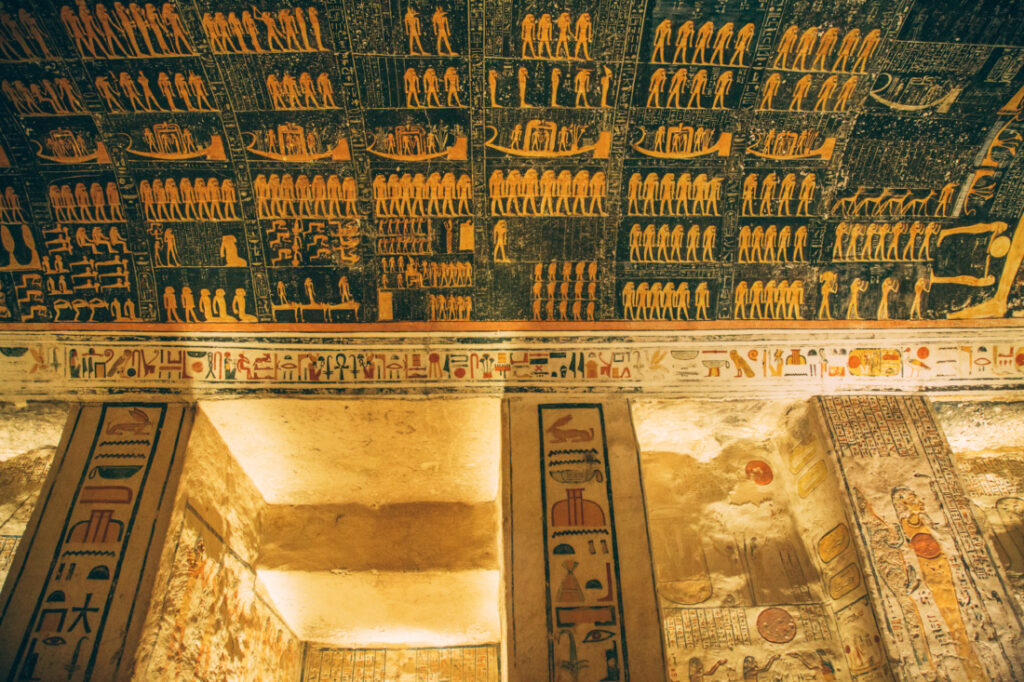




11. Despite the Common Perception That the Valley of the Kings is Filled With Vast Treasures, Most of the Tombs Were Looted in Antiquity
You might think that the Valley of the Kings is brimming with golden treasures, but that’s not quite the case. Most of the tombs were looted long ago.
For centuries, thieves targeted these royal resting places. They stole the precious artifacts that were meant to accompany the pharaohs into the afterlife.
By the time archaeologists reached the tombs, many were empty of their treasures. It’s a sad fact, but it’s part of the history of the Valley of the Kings.
However, this doesn’t make the site any less fascinating. The tombs themselves, with their intricate carvings and stunning hieroglyphics, are treasures in their own right.

12. The Valley of the Kings Remained an Active Burial Site for Approximately 500 Years, From the 16th to the 11th Century BCE
The Valley of the Kings wasn’t built overnight. In fact, it was an active burial site for about 500 years, starting from the 16th century and lasting until the 11th century BCE. This period is known as the New Kingdom of Egypt, a time when the country was at its most prosperous and powerful.
During these centuries, the valley was a hive of activity. Artisans, builders, and priests were constantly working to create and decorate the tombs. Each new pharaoh wanted their final resting place to be grander and more elaborate than the last. This resulted in the stunning array of tombs we see today.
It’s important to note that not every pharaoh from this period was buried in the Valley of the Kings. Some chose different locations for their tombs, but the valley remained the most popular choice for royal burials during this time.
The end of the New Kingdom marked the end of the valley’s use as a royal burial site. The tombs were sealed, the workers moved on, and the valley fell into silence. But the legacy of those 500 years lives on, preserved in the stunning tombs that draw visitors from around the world.
13. The Valley of the Kings is a UNESCO World Heritage Site and Has Attracted Tourists and Archaeologists From Around the World
The Valley of the Kings has been recognized as a UNESCO World Heritage Site. This means it’s been identified as having outstanding universal value, and it’s protected by international treaties.
This recognition has only increased its appeal. Every year, tourists and archaeologists from all corners of the globe flock to the Valley. They come to marvel at the ancient tombs, explore the history of the pharaohs, and perhaps even make a new discovery.
But it’s not just about the past. The Valley of the Kings continues to be a living, breathing site of exploration and study. New tombs and artifacts are still being discovered, adding to our understanding of this incredible civilization.

14. Be Sure to Visit the Temple of Hatshepsut
The Temple of Hatshepsut is on your way to the Valley of the Kings from Luxor. It is AMAZING, as is the ruler – Queen Hatshepsut.
Hatshepsut, widely accepted as one of the most successful pharaohs among Egyptologists, built this temple to commemorate her achievements and pay homage to the gods.
The temple stands out with its unique design, featuring terraces, colonnades, and a vibrant array of reliefs. The stories etched on the walls depict the birth of Hatshepsut, her coronation, and her successful trading expeditions.
Photo Gallery: The Temple of Hatshepsut Outside the Valley of the Kings



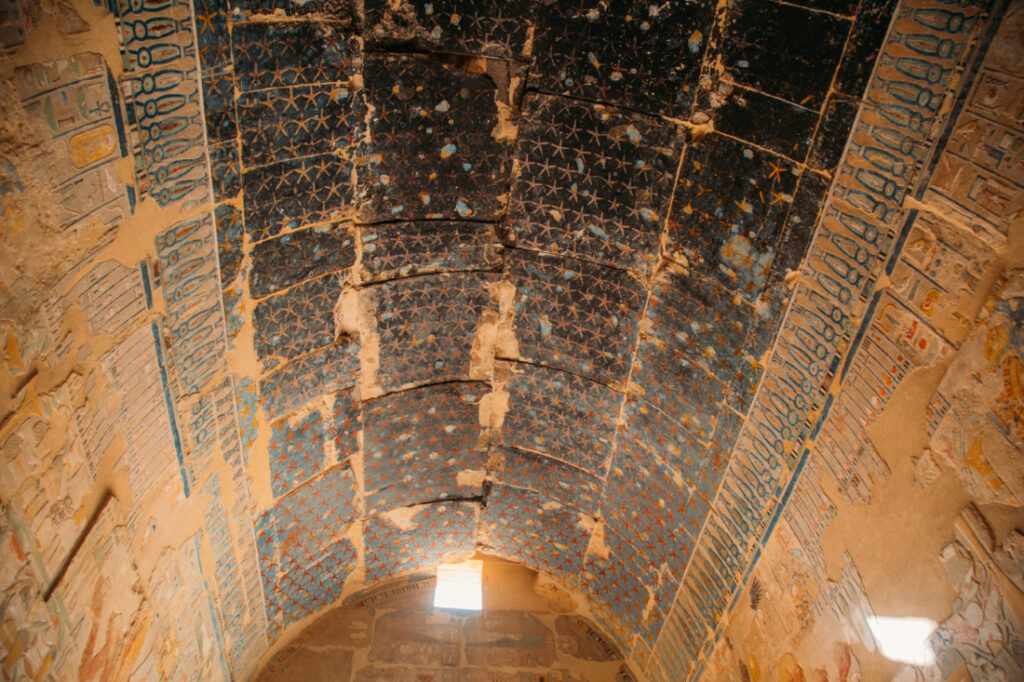



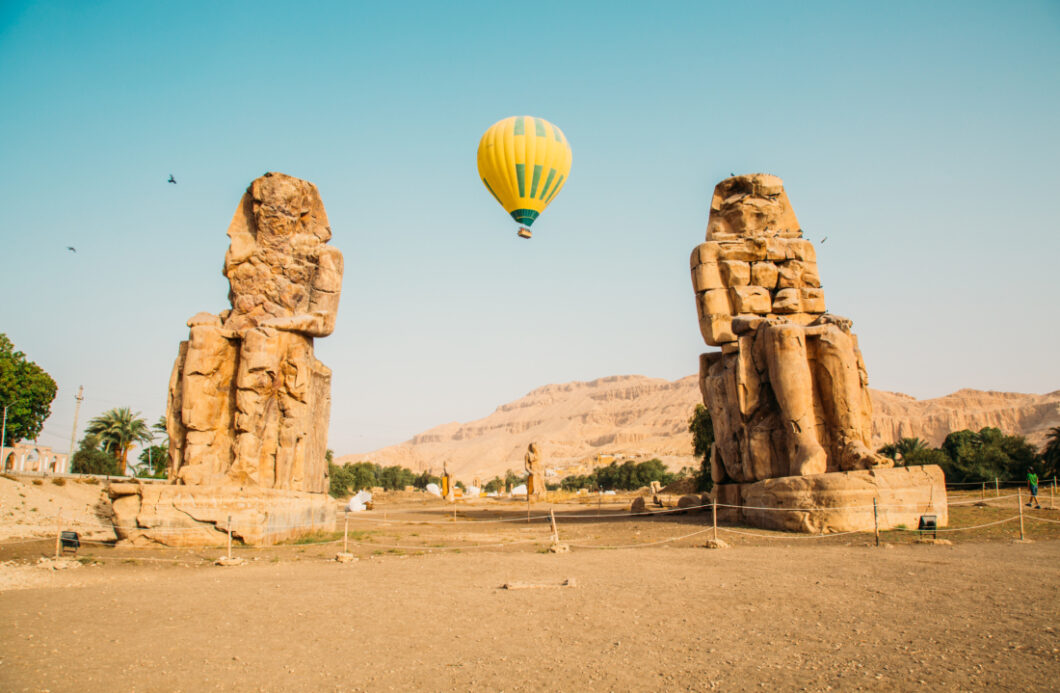
15. The Colossi of Memnon Are Also Along the Way, and Are Awesome if You Go in the Morning!
They are massive stone statues of the Pharaoh Amenhotep III. They have stood here for the past 3,400 years! Standing at a towering 60 feet high, they are one of the most impressive sights in Egypt.
The best time to visit the Colossi is in the morning when you can see hot air balloons flying over them!

16. There Are a Few Different Ways to Get to the Valley of the Kings
Traveling to the Valley of the Kings can be an adventure in itself. You can choose to take a taxi or a local bus from Luxor. The taxi ride is about 40 minutes long and quite comfortable. If you prefer a more local experience, the bus ride takes a bit longer but it’s a great way to see the local life.
You can hire a car to get there (many do this right through their hotel), I’ve also heard of people hiking and biking to get there (but it’s SO hot – I would NOT want to attempt that).
Another exciting way to get to the Valley of the Kings is by taking a hot air balloon ride. It’s an unforgettable experience with breathtaking views of the Nile and the surrounding landscape. This is a more expensive option but it’s worth every penny.
And you obviously also have the option of a tour. We had booked through Memphis Tours, and Ahmed was the best tour guide I think I’ve ever had in my entire life!
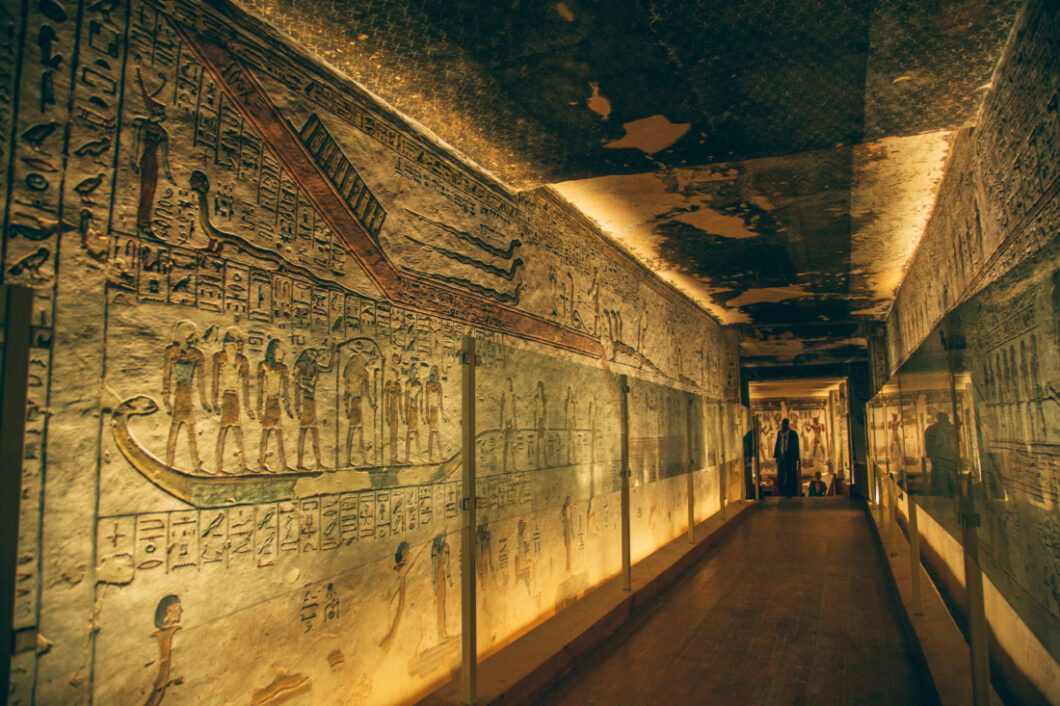
17. However, if You Do Take a Tour, Note That Guides Are Not Allowed Inside the Tombs!
If you’re planning to visit the Valley of the Kings, it’s important to know that tour guides are not allowed inside the tombs. This rule is in place to preserve the delicate interiors of these ancient burial sites.
So, what does this mean for your visit?
Well, before you enter each tomb, your guide will explain what you’re about to see. They’ll give you the history, the significance, and the context. They’ll tell you about the pharaoh buried there, the art on the walls, and any notable features.
You’ll then explore the tomb on your own, taking in the incredible history and detail without distraction.

18. Be Sure To Visit The Egyptian Museum In Cairo
If you’re planning a trip to the Valley of the Kings, it’s worth taking the time to visit the Egyptian Museum in Cairo. This museum is a treasure trove of ancient Egyptian artifacts, with over 120,000 items on display.
Here, you can see the golden mask of Tutankhamun, royal mummies, and countless other relics from the time of the pharaohs. It’s a great way to get a deeper understanding of the history and culture that created the Valley of the Kings. Plus, it’s a great way to escape the heat for a few hours!
You can read all about our visit to the Egyptian Museum here.
If you have any questions about visiting the Valley of the Kings – let me know in the comments!
Before you go, be sure to check out all of my posts about our travels to Egypt and read my post about must-see places in Luxor! Find my 2-day Luxor itinerary here, my complete women’s packing list for Egypt here, and a full 7-day itinerary for Egypt here!
Valley of the Kings Photos: Inside the Tombs





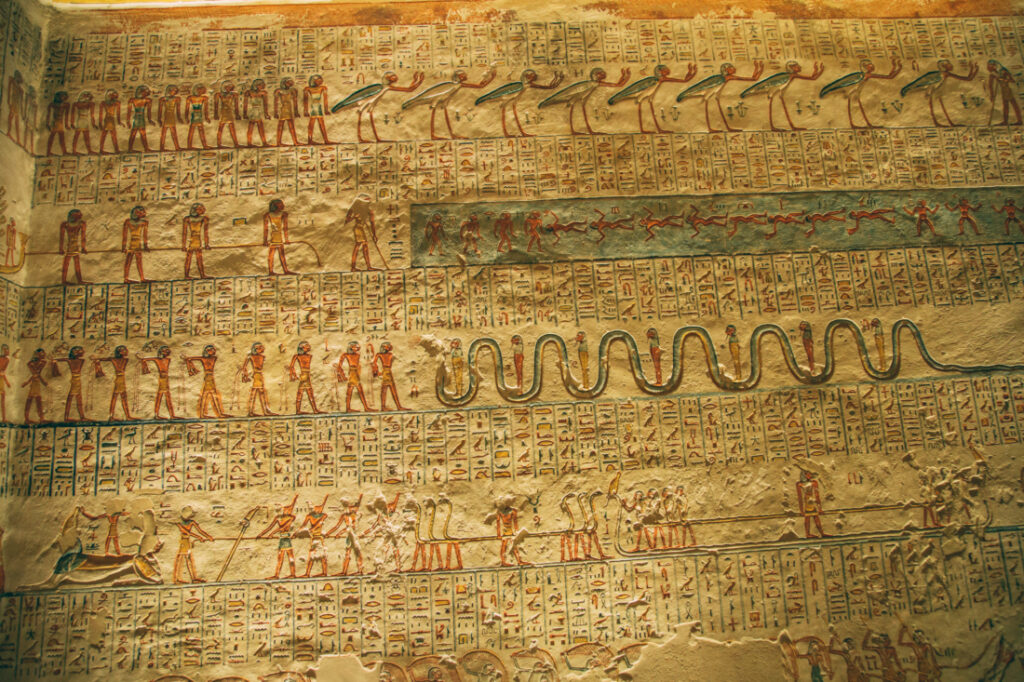




















*Disclosure: some of these links are affiliate links. Meaning, if you click a link and make a purchase, Have Clothes, Will Travel gets a very small commission at no extra cost to you. Thank you for supporting the brands that make this blog possible! I am also a participant in the Amazon Services LLC Associates Program, an affiliate advertising program designed to provide a means for us to earn fees by linking to Amazon.com and affiliated sites.


travelling in May this year from Canada and then ending in Dubai for 4 nights. WE have a fournight cruise as well and will be going to Abu Simbel. We are so looking forward to this and love all your writings on your experience. Truly it will help us.
I’m in awe! Sure would be cool to visit one day!
I hope you get the chance one day!
Oh wow this is great advice. It is seeming like more and more I’m finding certain places charge for photography. It’s a good thing iPhones are really good now. I wouldn’t want to leave my camera either.
Definitely! But just to be clear, you even have to pay for photos taken with an iPhone here!
Gosh…this is so interesting Lindsey. No guides inside?? Did they say why?
And the photography thing I”m assuming doesn’t include your phones??
XOXO
Jodie
I’m not entirely sure why guides aren’t allowed inside. I’m thinking it might have to do with keeping the tombs from getting too congested, as it’s just some rather narrow paths in and out and there wouldn’t be a good spot for tour groups to stop and talk (without causing a traffic jam). And photography also includes phones! Thank you for reminding me. It’s best to just keep your phone in your bag or pocket if you don’t want to pay the photography fee.